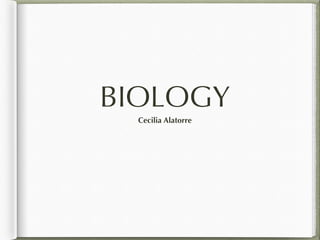Recommended
More Related Content
What's hot
What's hot (20)
Metabolism for Engineers (Useful for B.Tech., B.E. students)

Metabolism for Engineers (Useful for B.Tech., B.E. students)
Chapter 6 life processes 1 (introduction, nutrition and digestion)

Chapter 6 life processes 1 (introduction, nutrition and digestion)
Similar to Biology
Similar to Biology (20)
Physiology of Cell, Tissues, Membranes and Glands.ppt

Physiology of Cell, Tissues, Membranes and Glands.ppt
1. Introduction to structure of biomolecules lecture Lecture 2-1.pptx

1. Introduction to structure of biomolecules lecture Lecture 2-1.pptx
Recently uploaded
God is a creative God Gen 1:1. All that He created was “good”, could also be translated “beautiful”. God created man in His own image Gen 1:27. Maths helps us discover the beauty that God has created in His world and, in turn, create beautiful designs to serve and enrich the lives of others.
Explore beautiful and ugly buildings. Mathematics helps us create beautiful d...

Explore beautiful and ugly buildings. Mathematics helps us create beautiful d...christianmathematics
APM Welcome
Tuesday 30 April 2024
APM North West Network Conference, Synergies Across Sectors
Presented by:
Professor Adam Boddison OBE, Chief Executive Officer, APM
Conference overview:
https://www.apm.org.uk/community/apm-north-west-branch-conference/
Content description:
APM welcome from CEO
The main conference objective was to promote the Project Management profession with interaction between project practitioners, APM Corporate members, current project management students, academia and all who have an interest in projects.APM Welcome, APM North West Network Conference, Synergies Across Sectors

APM Welcome, APM North West Network Conference, Synergies Across SectorsAssociation for Project Management
This presentation was provided by William Mattingly of the Smithsonian Institution, during the third segment of the NISO training series "AI & Prompt Design." Session Three: Beginning Conversations, was held on April 18, 2024.Mattingly "AI & Prompt Design: The Basics of Prompt Design"

Mattingly "AI & Prompt Design: The Basics of Prompt Design"National Information Standards Organization (NISO)
Recently uploaded (20)
Explore beautiful and ugly buildings. Mathematics helps us create beautiful d...

Explore beautiful and ugly buildings. Mathematics helps us create beautiful d...
APM Welcome, APM North West Network Conference, Synergies Across Sectors

APM Welcome, APM North West Network Conference, Synergies Across Sectors
Interactive Powerpoint_How to Master effective communication

Interactive Powerpoint_How to Master effective communication
BAG TECHNIQUE Bag technique-a tool making use of public health bag through wh...

BAG TECHNIQUE Bag technique-a tool making use of public health bag through wh...
Ecosystem Interactions Class Discussion Presentation in Blue Green Lined Styl...

Ecosystem Interactions Class Discussion Presentation in Blue Green Lined Styl...
Measures of Central Tendency: Mean, Median and Mode

Measures of Central Tendency: Mean, Median and Mode
Mattingly "AI & Prompt Design: The Basics of Prompt Design"

Mattingly "AI & Prompt Design: The Basics of Prompt Design"
Presentation by Andreas Schleicher Tackling the School Absenteeism Crisis 30 ...

Presentation by Andreas Schleicher Tackling the School Absenteeism Crisis 30 ...
A Critique of the Proposed National Education Policy Reform

A Critique of the Proposed National Education Policy Reform
Biology
- 2. Scientific Method Control group: comparison group, compare result from experimental groups. Experimental group: tested group, subject to experiment. Dependent variable: factor depending on I.V, it's the result of experiment. Independent variable: factor you can modulate during the experiment instant Design Observation Collect information Hypothesis Experimental disgn Experiment&data collecting Data analysis Conclusion Write a scientific paper Peer review Publication
- 3. Macromolecules Group Functions Examples Location Carbohydrates Store energy Cooperation w/t lipids and proteinsy Glucose, fructose, maltose Pasta, bread, fruits, vegetables Lipids (fats) Store energy Provide barriers Thermic regulations Phospholipids, fatty acids Oil, nuts Proteins Transport substances Keep cell structure Transmit signals Make hormones Human grown Hemoglobin Factor hormone Meat, fish, milk, eggs Nucleic Acids Store and communicate genetic information DNA RNA Macromolecules are the large molecules joined by smaller organic molecules together.
- 4. Animal Cell
- 5. Plant Cell
- 6. Photosynthesis Light energy is converted into chemical energy. Chemical Formula: 6CO2 + 6H2O -light-> C6H12O6 + 6O2 Where does it occur? Chloroplast 2 phases: 1 light reaction: Chloroplast capture light. 2 the Calvin Cycle: Energy is store in glucose
- 7. Cellular respiration Glycolysis: glucose is broken down in the cytoplasm. Krebs cycle: transported to the mitochondria and converted to carbon dioxide. Electrons transportation: final step in the breaking down of glucose. Electrons move along the mitochondrial membrane from one protein to another. • Protons and electrons are transferred to oxygen to form water.
- 8. Carrier protein(molecules) The proteins may assist in the movement of substances by facilitated diffusion or active transport. Facilitated diffusion is used especially in the case of large polar molecules and charged ions; once such ions are dissolved in water they cannot diffuse freely across cell membranes
- 9. Energetic molecules They are those that degrade cellular metabolism we provide chemical energy in the form of ATP. ATP NADH NADP
- 10. Lactic fermentation Is a biological process by which glucose, fructose, and sucrose are converted into cellular energy and the metabolite lactate. Occurs in some bacteria and animal cells, such as muscle cells.
- 11. Energy Energy is the ability to do work. Thermodynamics is the study of the flow and transformation of energy. All organisms need energy to live.
- 12. Autotrophs Organisms that make their own food. Heterotrophs Need to ingest food to obtain energy.
